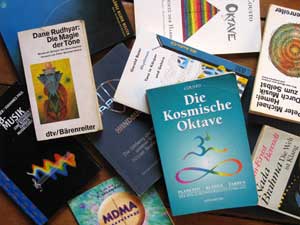
deutsch
Theory |
Dates | Music | About | Practice | Links | Pictures | Cosmic Octave |
|
||||||||||||||||||||||||
| contact deutsch |
||||||||||||||||||||||||
|
| Theory |
The entire universe is in constant vibration - from the smallest elementary particle to the largest accumulation of stars. Vibrations are processes where the physical state of matter changes periodically in time.
illustration: representation of the duration of time as y(t) in relation to one harmonical vibration
It is the speed of vibration which is responsible for the possibility of hearing, seeing, feeling up to the point of not being able to perceive anything, because the speed might be too fast or too slow for our sense perception. We are in the position of hearing vibrations with a frequency of 20 vibrations per second ( 20 Hz) up to approximately 16000 vibrations per second (16000 Hz or 16 kHz). This corresponds to the range of eight octaves. We are able to see vibrations with a speed of 375 billions Hz up to 750 billions Hz. This corresponds to the range of one octave. to put it simply: The idea of spherical harmony – a spherical music which is based upon all cosmic appearances – is as old as humanity and
amongst others is confirmed by modern physics. Hans Cousto, a swiss mathematician had a brilliant idea in 1978 – the simple idea that the acoustic phenomenon of the octave can be appropriated beyond our sense of hearing ( to form an octave is to double a frequency or to halve it.) The mathematical formula to calculate any periodic occurrence with octave-analogue tones and rythms is described as follows: |
|||
|
|||
The formula of the octave makes it possible to hear occurrences, which reach beyond our sense perception when for example rotations of the planets or vibrations of molecules are being transposed into octave-analogue colors, tones and rhythms. I am using these 'real frequencies' to create affective fields of sound and musical structures with the aid of correctly tuned, electronic sound production and the use of rows of overtones devised from diatonic intervals. The Akasha Project Performance is apart from - its musical style - a ritual of frequency and synchronicity with modal, electronic overtone music. |
|||
Literature |
|||
 |
|||